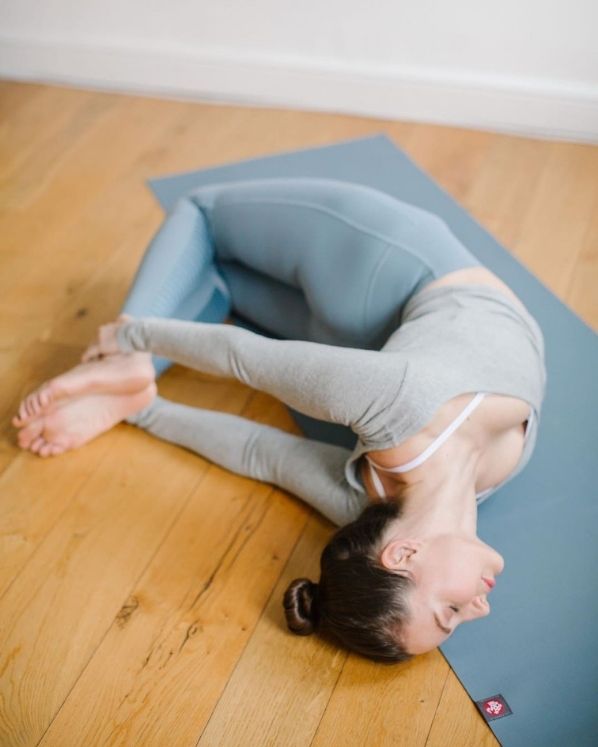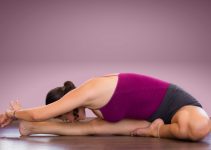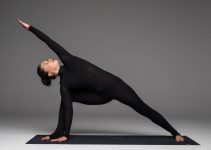
Parsva dhanurasana is a back-bending stretching pose. It is performed in a prone position.
Basically it’s a variant of bow pose in which the body is rolled to sidewards to increases the spread the stretching effect. The challenges involved in the asana makes it an intermediate level pose.
Parsva dhanurasana is also known by its English name, side bow pose, or flank bow pose.
It involves stretching of the spine and abdominal muscles. Apart from this, it benefits feet, ankles, chest, knees, and quadriceps.
Meaning and Interpretation
In Sanskrit, ‘Parsva’ means side or flank, ‘dhanu’ refers to ‘bow, and ‘asana’ means ‘pose.’ It is named so as while performing the asana the body resembles the shape of a bow; a bow placed on the ground.
Both the feet are held by the hands generating two complementary motions in the body. It involves the forward movement in the shoulder and backward push in the legs. These two opposite forces create a space within the lumbar region of the back.
It is a variant of dhanurasana with a slight difference of leaning the body over to the side. It is performed side-wise, therefore it deeply stretches each side individually.
Side Bow Pose Practice Guide
Follow the guide below to perform the side bow pose;
Contraindications
- Avoid parsva dhanurasana in case of pregnancy, heart diseases, neck, or lower back injury.
- If you have a migraine then skip performing this asana.
- Never perform it if you are suffering from a hernia.
Preparatory poses
- Cobra pose (Bhujangasana)
- Bridge pose (Setu Bandha Sarvangasana)
- Reclining Hero Pose (Supta Virasana)
How to Do Parsva Dhanurasana
- Lie in the prone position on the mat.
- Bring your head up and bend your knees projecting the toes towards your head.
- Inhale and hold your ankles with your hands.
- Lift the thighs off the floor and try to pull your arms and lift the legs as much as possible.
- Inhale and roll your shoulders forward.
- Exhale and bring your right shoulder towards the floor.
- Squeeze the knee together and keep the neck aligned with the spine
- Keep your gaze towards your nose and be in bow pose on the sides.
- Stay in the pose for 5 breaths.
- Exhale and roll onto your stomach and dive into the left side.
- Perform the same steps on the left and take 5 breaths.
- Finally, return t the center rolling onto your stomach.
- Release and straighten the legs and relax into the prone position.
Beginner’s tips
- While maintaining the pose side-wise there is a tendency that the upper knee is lifted. Keep your focus on it and try to squeeze it towards the other knee.
- Maintain the posture keeping the required body alignments in mind.
Precautions
- Avoid performing parsva dhanurasana after having a meal. There should be a three hours longs window between the meal and the practice.
- Do not perform it at night especially before sleeping hours.
- While pulling the thighs and chest do not bend the elbows. Maintain the pulling force equally on the upper and lower body.
- Do not let the knees go past the shoulders. Keep them aligned.
Counter poses
- Child’s Pose (Balasana)
- Seated Forward Bend (Paschimottanasana)
- Standing Forward Bend (Uttanasana)
- Corpse Pose (Shavasana)
Props and Modifications
Use the following props to modify the side bow with easy its easy variations.
- Yoga strap – If it is challenging for you to hold the ankles by the hands using a yoga strap will do. Wrap it around both the feet and use the ends to hold to maintain the shape of the bow.
- Bolster or blanket – Keep a bolster or blanket under the pelvis and then go for reaching your ankles, this will aid in lifting the chest. It will make the back-bend deeper and supports the upper body as well.
Parsva Dhanurasana Benefits
1. Stretches and strengthens muscles
Parsva dhanrasana provides an extreme stretch to the spine, neck, shoulders, chest, and abdomen. It also stretches the arms, legs, and opens up the hips. It makes the body flexible.
Along with stretching it makes all the involved muscles stronger.
2. Tones the body
The arm and leg muscles are engaged in the pose while maintaining the pose. It contracts the muscles and leaves them well toned.
3. Improves respiratory system
Side bow pose involves the expansion of the chest. It enhances the breathing capacity by expanding the lungs. It also cures any respiratory ailments like asthma. There is a supporting study [efn_note] The Effects of Regular Yoga Practice on Pulmonary Function in Healthy Individuals: A Literature Review https://www.liebertpub.com/doi/abs/10.1089/acm.2011.0516 [/efn_note] that proves the regular practice of side bow pose improves pulmonary functions.
4. Heals digestive disorders
Parsva dhanurasana involves back-bending which stretches the abdominal cavity. Besides this, the rolling involved in the asana massages and stimulates the abdominal organs.
It improves digestion. It can help in getting rid of constipation, other gastrointestinal or digestive ailments.
5. Activates reproductive system
The stretch involved also stimulates the reproductive organs. This stretches the muscles of the inner thighs and groin. It improves the blood circulation in these regions and activates the sex organs [efn_note] Side bow pose in infertility https://jaims.in/index.php/jaims/article/view/988/776 [/efn_note].
6. Reduces stress
Parsva dhanurasana provides a soothing effect on the nervous system. It helps in reducing fatigue and tension. Plus, the head is involved in the inversion that allows blood flow to the brain. Thus it reduces stress and anxiety.
7. Improves posture
The asana is incredible to make the spine flexible. It helps in getting rid of any hunching or slouching of the back. This eventually corrects the posture.
8. Activates the Manipura chakra
Side bow pose involves stretching of the abdominal cavity. This stimulates the solar plexus (Manipura chakra), which in turn boosts energy, self-esteem, and confidence. According to a study [efn_note] Use of Yoga Elements in the Training of Martial Arts http://www.jett.dormaj.com/docs/Volume8/Issue%202/Use%20of%20Yoga%20Elements%20in%20the%20Training%20of%20Martial%20Arts.pdf [/efn_note], it also enhances the self-control and confidence to take actions
9. Tones the glands
Side bow pose massages and soothes the liver, pancreas, and adrenal glands. This improves their functioning and stimulates their secretion. It helps in detoxification of the body.
10. Weight loss
It is one of the major benefits of parsva dhanurasna. By stretching the abdominal region it helps in shedding extra body fat and provides a toned body.
Conclusion
Indulge in parsva dhnaurasana with complete surrender to the divine. It elevates self-esteem and instills a sense of confidence.
It requires a lot of practice to master the pose, however, there are a lot of reasons not to give up on it. Keep practicing to reach the hidden inner potential of yourself.




